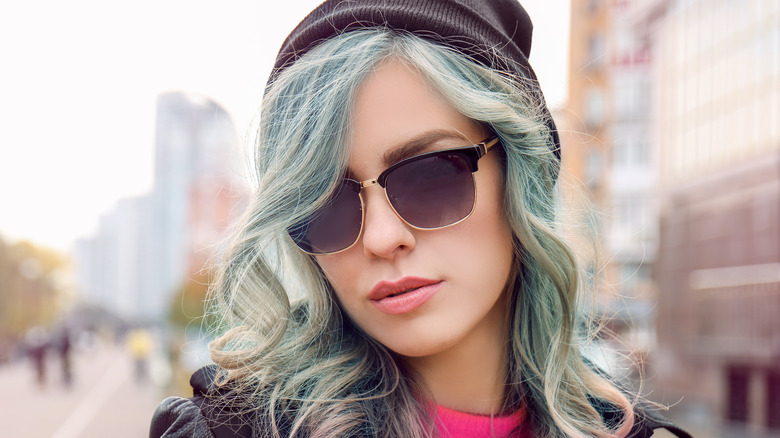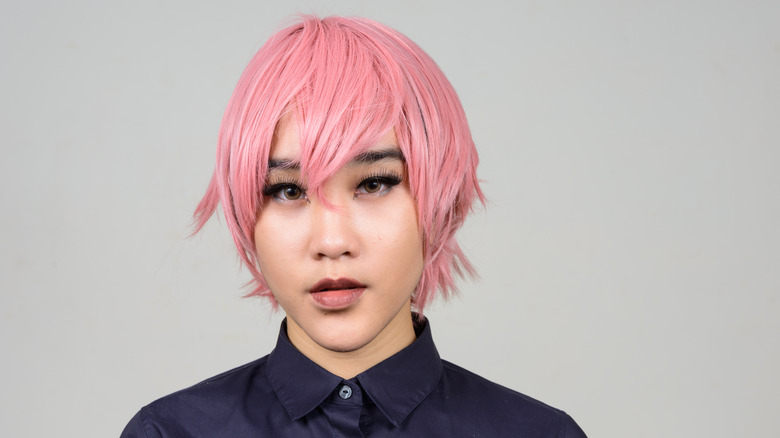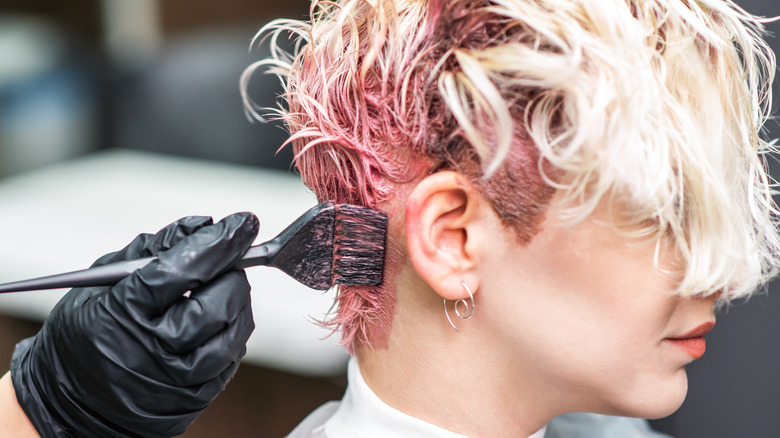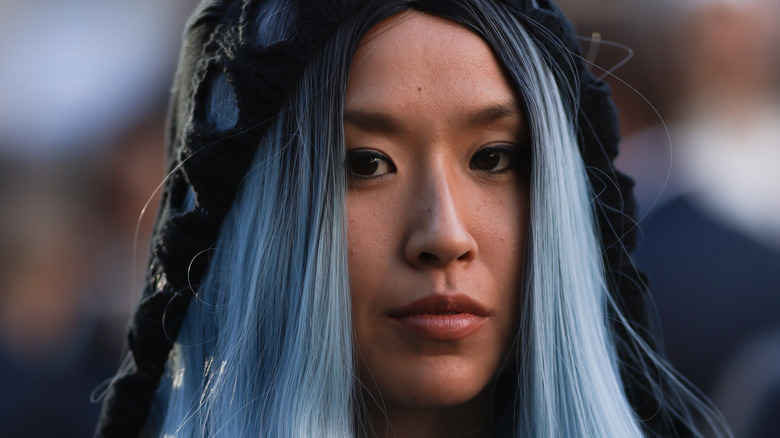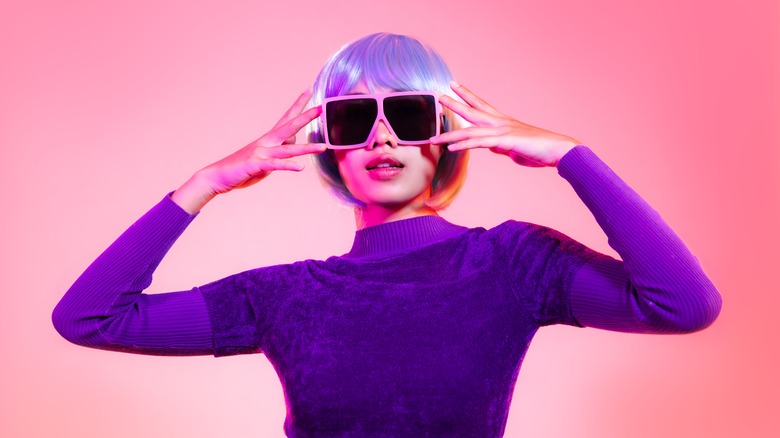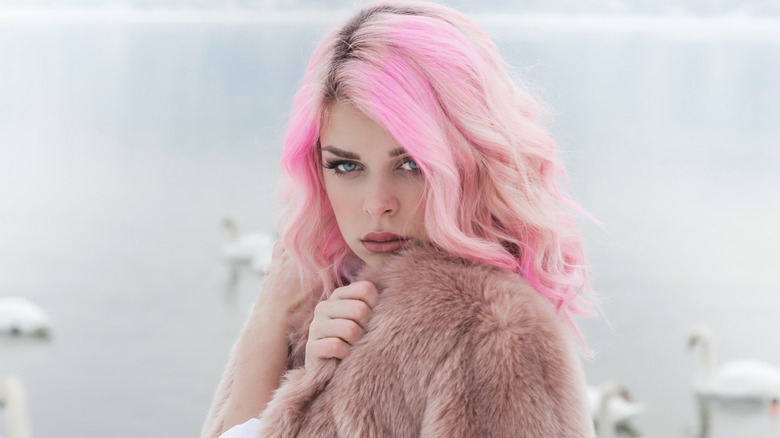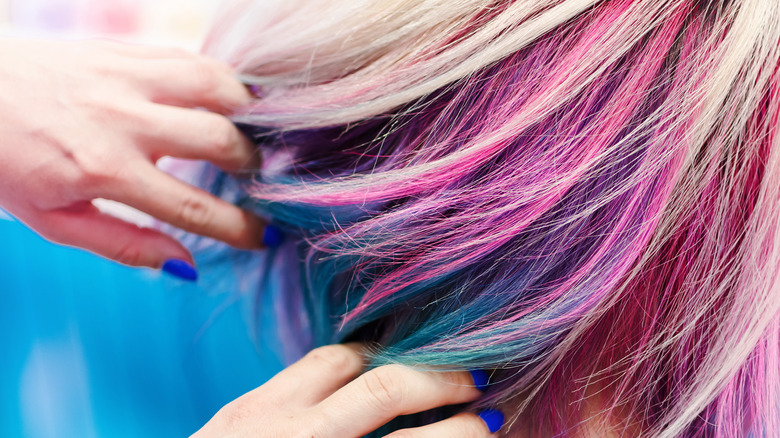What You Need To Know Before Dyeing Your Hair A Pastel Color
Pastel hair colors have become a more popular choice for those looking to experiment with rainbow-hued hair colors without going too bold, providing a good option for anyone whose daily life might not be suited to rocking anything too far past a "natural" color.
Many might look at pastel hair colors and think that a lighter color means less time in a salon chair. These shades certainly seem like they require less effort to maintain than red hair, for example, which is known to require lots of upkeep. However, experts have revealed that those who think pastel hair colors are less work would be mistaken, per HuffPost. Instead, those looking to go pastel should know what they're signing up for in advance. That extends beyond the initial salon visit too, as pastel hair requires quite a bit of aftercare — an important step for keeping hair healthy and looking its best.
Be aware of what you're starting with
First things first, pastel hair colors won't show up on hair that isn't already blonde. As hair stylist Tina Outen tells Seventeen, "Yellow tones will interfere with a cool color, so if you want blue hair, you need your hair to be very pale blonde. On the other hand, if you want pink or mint hair, a more yellow blonde will work." In other words, the shade you're starting with can vary a little bit depending on your end goal, but it's safer to go lighter.
On that note, HuffPost writes that people with certain hair types should make themselves aware that going pastel may be harder for them because of the effects of the bleach. This includes people who have previously dyed hair (hair that is not "virgin" hair), those with darker hair, and those with curly hair. Hair that is darker or that has been previously dyed is likely to require more treatment to get it to the desired color, and although curly hair can be bleached, the process can negatively impact the shape of the curls.
It can be time-consuming
As stylist Nicole Hamlet reveals to Yahoo!, getting hair dyed pastel by a salon professional can be time-consuming — and potentially expensive as a result. "Normally, in the salon, I charge $125 an hour because it can be very time-consuming," Hamlet explained, factoring in that hair needs to be bleached first and then color-treated. Overall, appointments take at least a few hours.
Meanwhile, Behindthechair.com stresses that you might require multiple sessions with your stylist in order to achieve the pastel color you're looking for. If you're worried about how long it might take, ask for a hair consultation before you commit to going pastel. That way, your stylist can let you know how many sessions you'll need, depending on your hair type and whether or not you've colored or bleached it before. During your consultation, you can also find out whether your desired shade is actually realistic for you to achieve. For example, qualified stylists may decline to bleach a client's hair if it's severely damaged already.
Consider your skin tone when choosing a color
Potentially having your hair color options limited by the type and state of your hair can be deflating. But you can explore colors you'd never thought of before by looking at your skin tone as a guide for color-matching. "If you have red tones ... in your skin, go for cooler shades like blue, green or lavender," Tina Outen tells Seventeen. "If you're very pale, warmer shades like pink and orange will look amazing."
If you aren't too sure what your skin tone is, exactly, or what color undertones your skin has, MasterClass notes that you can tell whether your skin has cold or warm undertones by considering your jewelry. Gold pieces generally look better on people with warm undertones, while silver suits those with cold undertones. Colorist Roxie Darling explains to Byrdie that it's also worth discussing your skin tone with your colorist during your consultation: "The decision you and your colorist have to make is which color you would like to bring out in your face."
You can dye your own hair if you know what you're doing
In general, it is better to leave the transformation to pastel hair to a professional. As Simply Organic Beauty explains, pastel colors require extensive bleaching to either platinum or white before the color can be applied. Professional stylists know what they're doing, and if you attempt to bleach and color your hair without that expertise, you risk severely damaging your hair.
If you are sure you know how to color your hair while avoiding damage (which, in the worst case, can result in your hair needing to be completely cut off), you can achieve pastel hair at home. There are plenty of guides out there about how to go about dyeing hair pastel yourself, such as one from Bellatory that includes the specifics in a step-by-step fashion. Specific products are also likely to come with their own instructions, and it isn't a bad idea to follow what the brand in question has recommended.
It may be expensive regardless
Attempting to save money by dyeing your hair yourself rather than going to a salon professional can sound like a great idea ... until it isn't. SheKnows warns that the costs associated with dyeing your hair pastel on your own can add up quickly. Between the initial bleaching and dyeing and caring for your hair after, it's possible that you're looking at about the same expenses as having a stylist do it all from the start — and that doesn't include going to the salon to fix any mistakes that you might have made at home.
Based on Nicole Hamlet's hourly fee of $125, as provided to Yahoo!, clients would be paying anywhere from $375 to $1,000, depending on how many hours it takes to bleach and dye their hair. Factoring in that going for a pastel hair color isn't likely to be a one-off experience, clients would then need to come back for additional salon services.
Pastel colors require maintenance
All dyed hair requires some level of maintenance by the very nature of its being dyed, but Tina Outen tells Seventeen that this is even more likely for pastel-colored hair: "The more 'baby' the color, the quicker it will wash out." And by "quick," hair stylists mean quick. Hair colorist Caitlin Ford explains to HuffPost that she will dye her clients' hair a darker color than intended because, "As they wash their hair, it's going to turn pastel anyway, and they'll have more of an anchor of that pastel in there, so it will last a little bit longer if we make it darker initially. If we do that, it might last two to three weeks more. So instead of six to eight weeks, it would last more like eight to 10."
Luckily, HuffPost notes that pink and purple dyes tend to fade better in comparison to blue dyes, which can become greenish as they fade.
